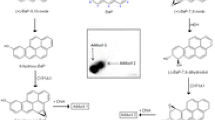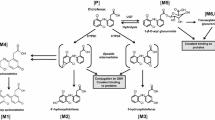Abstract
Two major forms of hepatic cytochrome P-450 (hepatic P-450MCI and P-450MCII) were purified approximately 5-fold from liver microsomes in Syrian golden hamsters treated with 3-methylcholanthrene (MC). The purified preparations of hepatic P-450MCI and P-450MCII contained 9.6 and 8.3 nmol cytochrome P-450 (P-450) per mg protein, respectively, and were essentially free from NADPH-cytochrome c (P-450) reductase (fpT), NADH-cytochrome b5 reductase and cytochrome b5. By sodium dodecylsulfate-polyacrylamide gel electrophoresis (SDS-PAGE), the molecular weights of hepatic P-450MCI and P-450 mMCII were estimated to be 56 000 and 53 500. Further, a major form of pulmonary P-450 (P-450MC) were purified from lung microsomes of MC-treated hamster, and contained 14.2 nmol P-450 per mg protein, and estimated to be 56 000 in monomeric molecular weight, indicating the similar molecular weight to hepatic P-450MCI in the hamster. From the absorption spectra the oxidized forms of hepatic P-450MCI and P-450MCII were high- and low-spin ferric hemoproteins, respectively, and pulmonary P-450MC was similar to hepatic P-450MCII in their hemoprotein spin state. No difference, however, was observed in the CO-reduced forms among hepatic P-450MCI, P-450MCII and pulmonary P-450MC, all exhibiting 446.5 nm Soret bands. In a reconstituted system containing fpT and dilauroylphos-phatidylcholine (DLPC), pulmonary P-450MC efficiently catalyzed benzo[a]pyrene (BP) hydroxylation at a rate of 11.4 mol formed per min per mol P-450, but hepatic P-450MCI and P-450MCII both exhibited lower levels, e. g., 0.49 and 0.54, respectively. These findings indicated a clear tissue difference in the activity of BP hydroxylation between lung and liver in MC-treated hamsters.
Similar content being viewed by others
References
Abe T, Watanabe M (1982) Genetic difference in the induction of aryl hydrocarbon hydroxylase and its components by 3-methylcholanthrene in liver and lung microsomes among four strains of guinea pigs. Biochem Pharmacol 31: 2077–2082
Abe T, Watanabe M (1983) Purification and characterization of three forms of microsomal cytochrome P-450 in liver from 3-methylcholanthrene-treated guinea pigs. Mol Pharmacol 23: 258–264
Burke MD, Prough RA (1976) Some characteristics of hamster liver and lung microsomal aryl hydrocarbon (biphenyl and benzo[a]pyrene) hydroxylation reactions. Biochem Pharmacol 25: 2187–2195
Chen Y-T, Lang MA, Jensen NM, Negishi M, Tukey RH, Sidransky E, Guenther TM, Nebert DW (1982) Similarities between mouse and rat liver-microsomal cytochrome P-450 induced by 3-methylcholanthrene. Eur J Biochem 122: 361–368
Cheng K-C, Gelboin HV, Song B-J, Park SS, Friedman FK (1984) Detection and purification of cytochrome P-450 in animal tissues with monoclonal antibodies. J Biol Chem 259: 12279–12284
Chiang JYL, Steggles (1983) Identification and partial purification of hamster microsomal cytochrome P-450 isoenzymes. Biochem Pharmacol 32: 1389–1397
Fujii H, Ohmachi T, Sagami I, Watanabe M (1985) Liver microsomal drug metabolism in ethanol-treated hamsters. Biochem Pharmacol 34: 3881–3884
Green U, Althoff J (1982) Carcinogenicity of vinylethylnitrosamine in Syrian golden hamsters. J Cancer Res Clin Oncol 102: 227–233
Greenlee WF, Poland A (1978) An improved assay of 7-ethoxy-coumarin 0-deethylase activity: induction of hepatic enzyme activity in C57BL/6J and DBA/2J mice by phenobarbital, 3-methylcholanthrene and 2,3,7,8-tetrachorodibenzo-p-dixon. J Pharmacol Exp Ther 205: 596–605
Guengerich FP, Martin MV (1980) Purification of cytochrome P-450, NADPH-cytochrome P-450 reductase, and epoxide hydratase from single preparation of rat liver microsomes. Arch Biochem Biophys 205: 365–379
Guengerich FP, Dannan GA, Wright ST, Martin MV, Kaminsky LS (1982a) Purification and characterization of liver microsomal cytochrome P-450: Electrophoretic, spectral, catalytic, and immunological properties and inducibility of eight isozymes isolated from rats treated with phenobarbital or β- naphthoflavone. Biochemistry 21: 6019–6030
Guengerich FP, Wang P, Davidson NK (1982b) Estimation of isozymes of microsomal cytochrome P-450 in rats, rabbits, and humans using immunochemical staining coupled with sodium dodecyl sulfate-polyacrylamide gel electrophoresis. Biochemistry 21: 1698–1706
Ioannides C, Parkinson C, Parke DV (1981) Activation of benzo[a]pyrene and 2-acetamidofluorene to mutagens by microsomal preparation from different animal species: role of cytochrome P-450 and P-448. Xenobiotica 11: 701–708
Laemmli UK (1970) Cleavage of structural proteins during the assembly of the head of bacteriophage T4. Nature 227: 680–685
Laskin S, Sellakumar A (1974) Models in chemical respiratory carcinogenesis. In: Karbe E, Park JF (ed) Experimental lung cancer. Springer, Berlin, Heidelberg, New York, pp 7–19
Litterst CL, Mimnaugh EG, Reagan RL, Gram TE (1975) Comparison of in vitro drug metabolism by lung, liver, and kidney of several common laboratory species. Drug Metab Dispos 3: 259–265
Lotlikar PD (1981) Metabolic and biochemical studies, metabolic activation of aromatic and dialkynitrosamines. J Cancer Res Clin Oncol 99: 125–136
Lowry OH, Rosebrough NJ, Farr AL, Randall RJ (1951) Protein measurement with the folin phenol reagent. J Biol Chem 193: 265–275
Lu AYH, West SB (1980) Multiplicity of mammalian microsomal cytochrome P-450. Pharmacol Rev 31: 277–295
Mass MJ, Kaufman DG (1983) A comparison between the activation of benzo[a]pyrene in organ cultures and microsomes from the tracheal epithelium of rats and hamsters. Carcinogenesis 4: 297–303
Matsubara T, Prough RA, Burke MD, Estabrook RW (1974) The preparation of microsomal fraction of rodent respiratory tract and their characterization. Cancer Res 34: 2196–2203
Matsushima T, Yahagi T, Takamoto Y, Nagao M, Sugimura T (1980) Species differences in microsomal activation of mutagens and carcinogens with special reference to new potent mutagens from pyrolysates of amino acids and proteins. In: Coon MJ, Conney AH, Estabrook RW, Gelboin HV, Gillette JR, O'Brien PJ (eds) Microsomes, drug oxidations, and chemical carcinogenesis. Academic Press, New York, pp 1093–1100
Nebert DW, Gelboin HV (1968) Substrate-inducible microsomal aryl hydroxylase in mammalian cell culture: I. Assay and properties of induced enzyme. J Biol Chem 243: 6242–6249
Nebert DW, Gelboin HV (1969) The in vivo and in vitro induction of aryl hydrocarbon hydroxylation in mammalian cells of different species, tissues, strains, and developmental and hormonal states. Arch Biochem Biophys 134: 76–89
Nebert DW, Negishi M (1982) Multiple forms of cytochrome P-450 and the importance of molecular biology and evolution. Biochem Pharmacol 31: 2311–2317
Nettesheim P, Griesemer RA (1978) Experimental models for studies of respiratory tract carcinogenesis. In: Harris CC (ed) Pathogenesis and therapy of lung cancer. Marcel Dekker, New York, pp 75–188
Nohmi T, Yoshikawa K, Nakadate M, Ishidate M Jr (1983) Species difference in the metabolic activation of phenacetin by rat and hamster liver microsomes. Biochem Biophys Res Commun 110: 746–752
Omura T, Sato R (1964) The carbon monooxide-binding pigment of liver microsomes I. Evidence for its hemoprotein nature. J Biol Chem 239: 2370–2378
Philpot RM (1974) Spectral analysis of a solubilized hepatic cytochrome P-450 preparation for determination of contamination by cytochrome b5 and unreactive cytochrome P-450. Chem-Biol Interact 9: 169–180
Ryan DE, Thomas PE, Reik LM, Levin W (1982) Purification, characterization and regulation of five rat hepatic microsomal cytochrome P-450 isozymes. Xenobiotica 12: 727–744
Sagami I, Watanabe M (1983) Purification and characterization of pulmonary cytochrome P-450 from 3-methylcholanthrene-treated rats. J Biochem 93: 1499–1508
Sellakumar AR, Montesano R, Saffiotti U, Kaufman DG (1973) Hamster respiratory carcinogenesis induced by benzo[a]pyrene and different dose level of ferric oxide. J Natl Cancer Inst 50:507–510
Slaughter SR, Wolf CR, Marciniozyn JP, Philpot RM (1981) The rabbit pulmonary monooxygenase system. Partial structural characterization of P-450. J Biol Chem 256: 2499–2503
Thomas PE, Reidy J, Reik LM, Ryan DE, Koop DR, Levin W (1984) Use of monoclonal antibody probes against rat hepatic cytochromes P-450c and P-450d to detect immunochemically related isozymes in liver microsomes from different species. Arch Biochem Biophys 235: 239–253
Thorgeirsson SN, Atlas SA, Boobis AR, Felton JS (1979) Species differences in the substrate specificity of hepatic cytochrome P-448 from polycyclic hydrocarbon-treated animals. Biochem Pharmacol 28: 217–226
Watanabe M, Konno K, Sato H (1978) Properties of aryl hydrocarbon (benzo[a]pyrene) hydroxylase in lung microsomes of mice. Gann Jpn J Cancer Res 69: 1–8
Watanabe M, Sagami I, Ohmachi T, Fujii H (1985a) Characteristics of purified cytochrome P-450s in microsomes of rat lung and Morris hepatoma 5123D. Gann Monogr Cancer Res 30: 19–36
Watanabe M, Sagami I, Ohmachi T, Fujii H (1985b) Comparison in the character of purified pulmonary cytochrome P-450 between 3-methylcholanthrene-treated rats and hamsters. In: Vereczkey L, Magyar K (eds) Cytochrome P-450. Biochemistry, biophysics and induction. Elsevier Science, Amsterdam, pp 379–382
Wiebel FJ, Leutz JC, Diamond L, Gelboin HV (1971) Aryl hydrocarbon (benzo[a]pyrene) hydroxylase in microsomes from rat tissues: differential inhibition and stimulation by benzoflavones and organic solvents. Arch Biochem Biophys 144: 78–86
Yamamoto A, Hisanaga A, Ishinishi N (1985) Comparative study on the carcinogenicity of N-nitrosodiethylamine and benzo[a]pyrene to the lung of Syrian golden hamsters induced by intermittent instillation to the trachea. Cancer Lett 25: 271–276
Yasukochi Y, Masters BSS (1976) Some properties of a detergent-solubilized NADPH-cytochrome c reductase purified by biospecific affinity chromatography. J Biol Chem 251: 5337–5344
Author information
Authors and Affiliations
Additional information
Dedicated to Professor Dr. med. Herbert Remmer on the occasion of his 65th birthday
Rights and permissions
About this article
Cite this article
Watanabe, M., Fujii, H., Sagami, I. et al. Characterization of hepatic and pulmonary cytochromes P-450 in 3-methylcholanthrene-treated hamsters. Arch Toxicol 60, 52–58 (1987). https://doi.org/10.1007/BF00296946
Issue Date:
DOI: https://doi.org/10.1007/BF00296946




